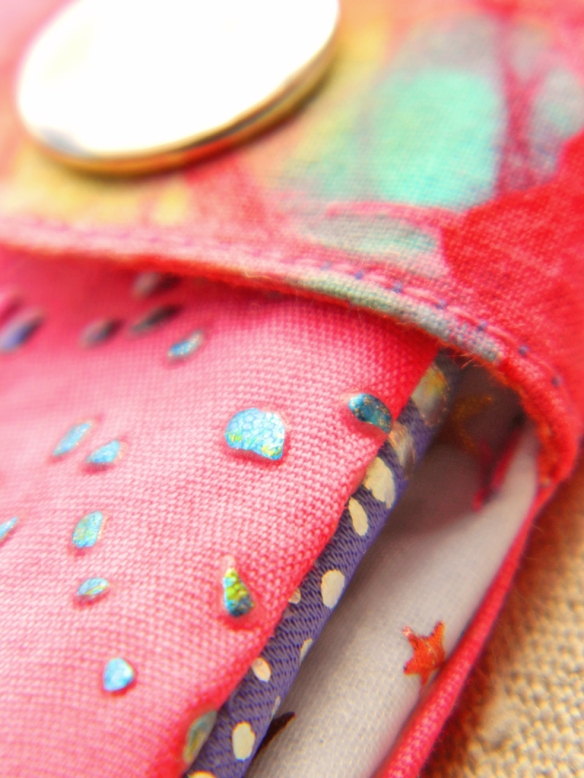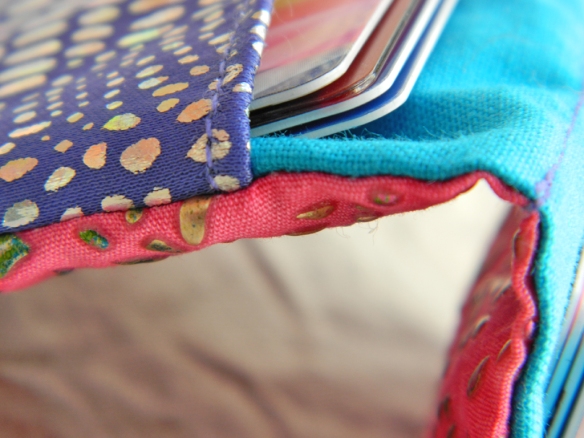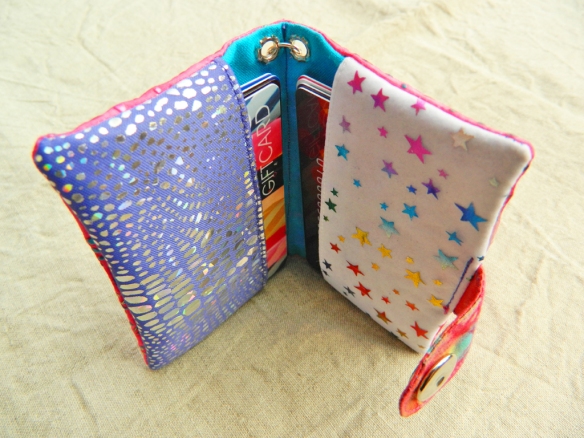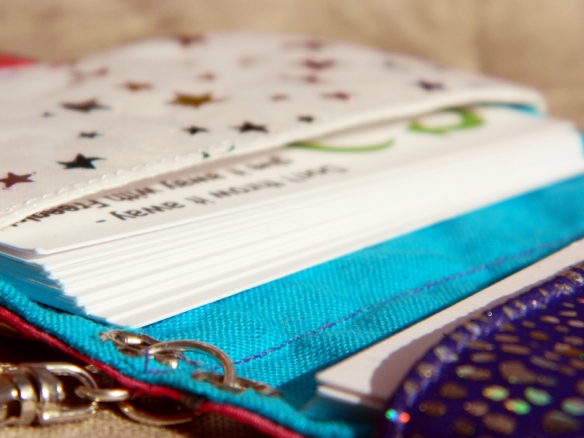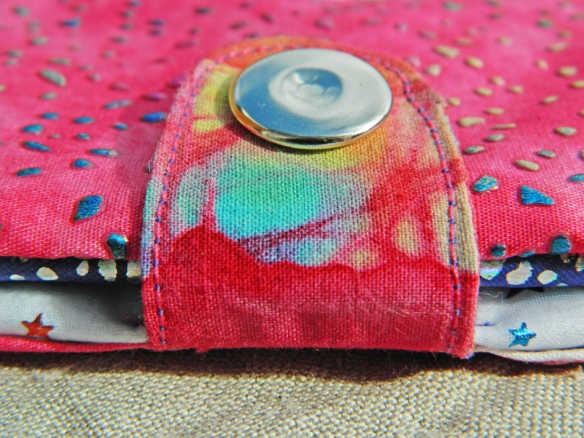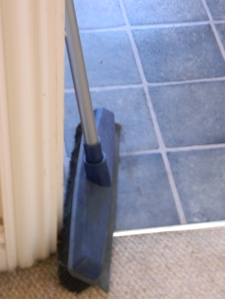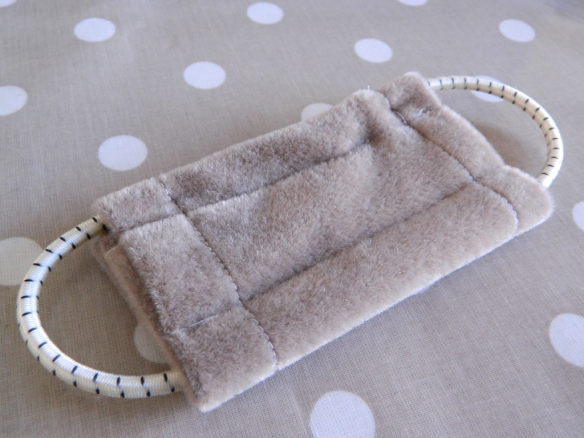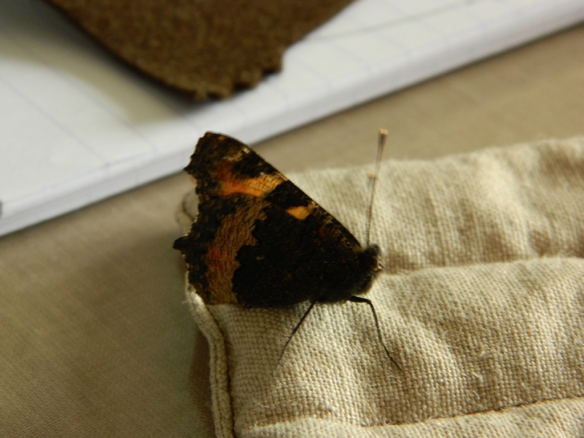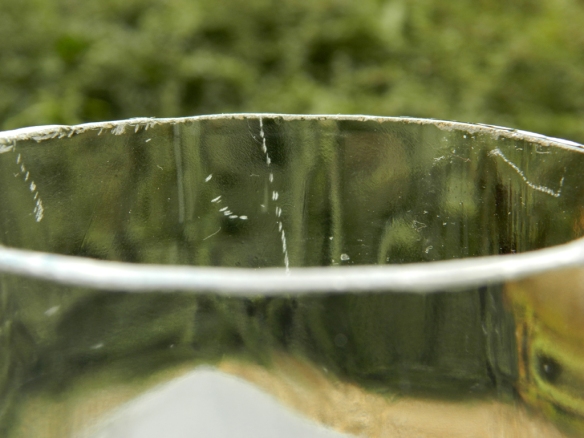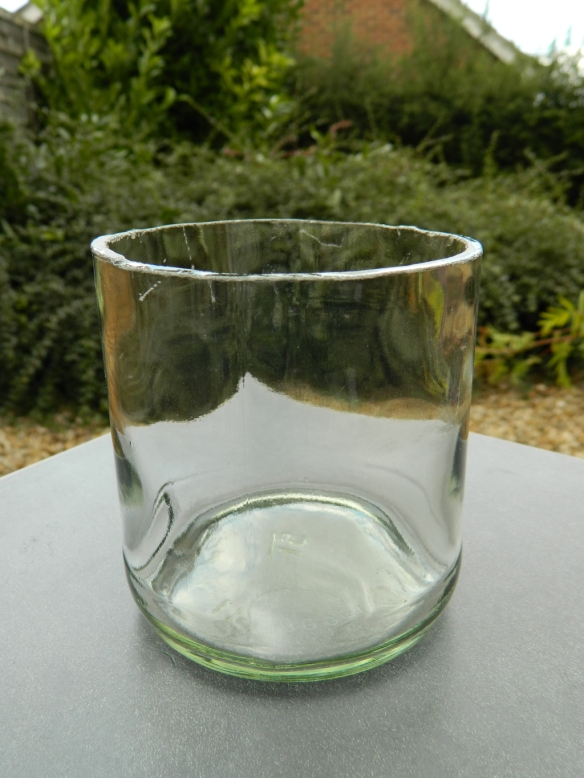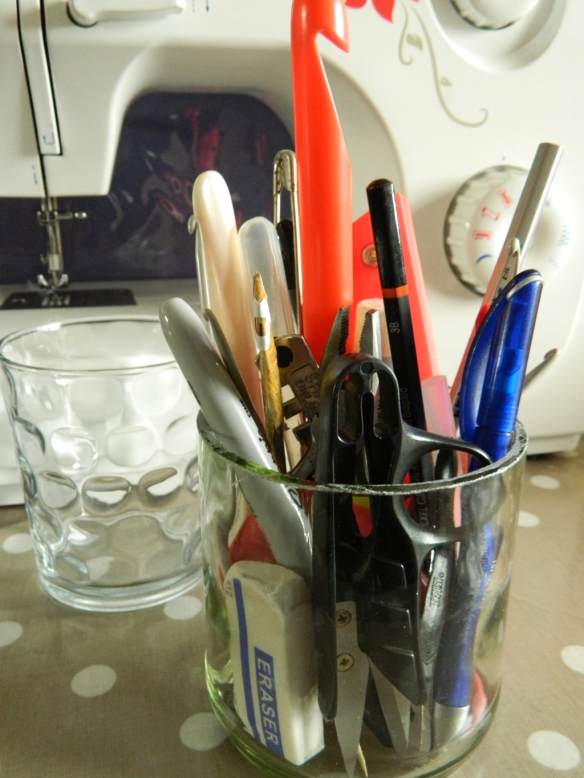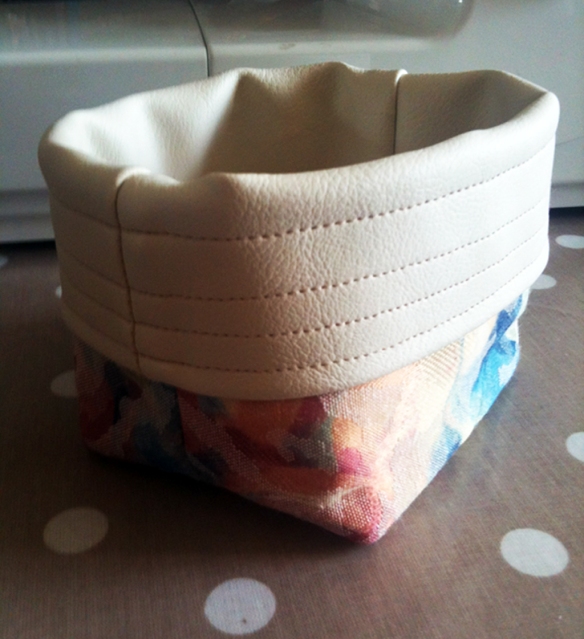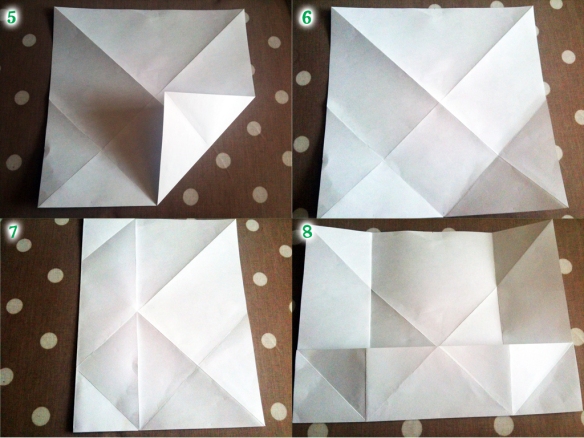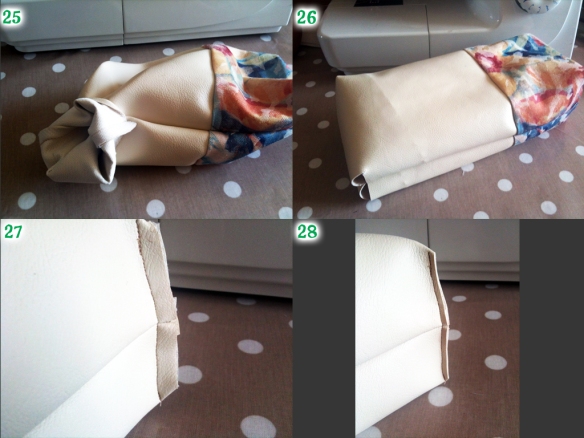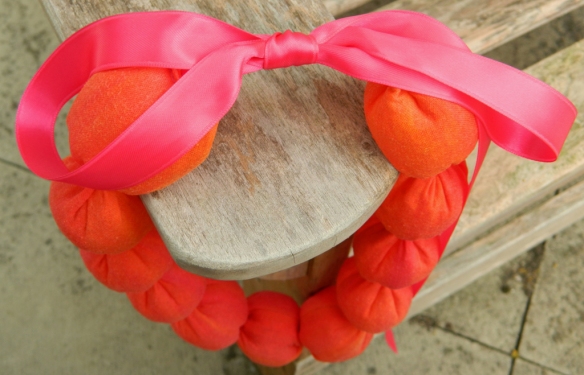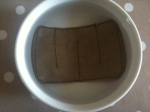Today’s entry is a card holder loosely based on this one: http://schlosserdesigns.blogspot.co.uk/2009/02/tutorial-tuesday-business-card-holder.html
I knew I wanted to make one as soon as I saw it, but I wanted to give it the Snotty Dog twist, so taking purely the twin pocket idea, I set about making my own with that little added extra “something”.
It is large enough to take store cards or even credit cards if you don’t have any business cards to fill it.
And the clip means you can attach it to the end of the zipper on an inside pocket of your bag so it doesn’t drift about in the bottom evading capture when you’re standing at the till, or trying to get your business card to someone who needs to dash off.
You will need:
A very small amount of fabric(s) of your choice, scraps even, or a fat quarter.
Coordinating thread(s)
2 small rivets. Even card making ones should be fine if that’s what you have.
Rivet setting tool (you usually get a basic one to use with a hammer in the pack)
1 snap fastener or press stud
1 small swivel clip
2 jump rings, one larger than the other to attach the clip. Or you could use a single smallish split ring- the type of thing you have your keys on. (I made my jump rings as I have jewellery pliers and wire, and it only takes a minute.)
Instructions:
First I checked the measurements and it turns out that the cards I’m making this for are (roughly) 3.5 x 2 inches.
I then decided I needed 3/8” for seam allowance, and ¼” for “ease” so that the cards aren’t rammed inside, and you have enough room to get one out easily, even if you have a fair sized stack in there. Plus then another inch in between the cards where the fabric folds over. This will allow room for your clip later.

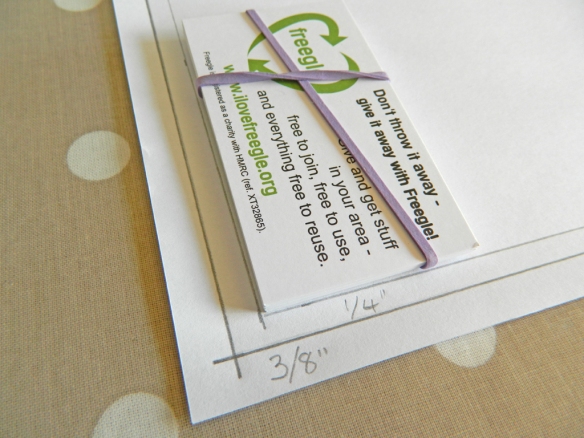
This is what the pattern should look like (I forgot to write on 3 1/2″ up the side as I was making this all up as I went along and took the pic before I realised), just note that that is inside (extra to) the 1/4″ and 3/8″ measurements:
And this is the pattern for the pocket pieces – note that the measurements include all the seam allowance all the way around but only on the pocket pattern. It would have been overly complicated to draw them in, and it’s easy enough to remember that ALL the seam allowances are 3/8″ on this project:
I went through my fabric stash and found these which I thought went together well (or clash so badly your eyes are now bleeding, it depends on your taste!). 😉 At this point I hadn’t fully made my mind up what the interior fabric would be, so I went looking in my stash and came up with a rather fetching turquoise that goes clashes particularly well. 😀
As the purple one has a significant one way stretch and was rather floppy, I stuck on some scrap interfacing from my stash. You may now be kicking yourself that you threw those bits away that you thought would be no use for anything. I am in no way encouraging hoarding – I am in fact helping, yes, “helping” you to bust your stash. Okay, I know this won’t bust your stash unless you make one for everyone you’ve ever known, loved, met, worked around and made eye contact with, but hey, it all helps.
You don’t need to have the interfacing all the way to the edge of the seam allowance, just enough to cover the rear of the main part that will be showing. As you can see, I wasn’t in any way precise:

I did the same with the star fabric as it’s a chiffon/tuille see-through type fabric and thin and floppy as hell, so it needed a bit of propping up. Again there’s no need to add bulk to your seams – though the truth is, the scrap of interfacing just happened to be this wide, so I took advantage:
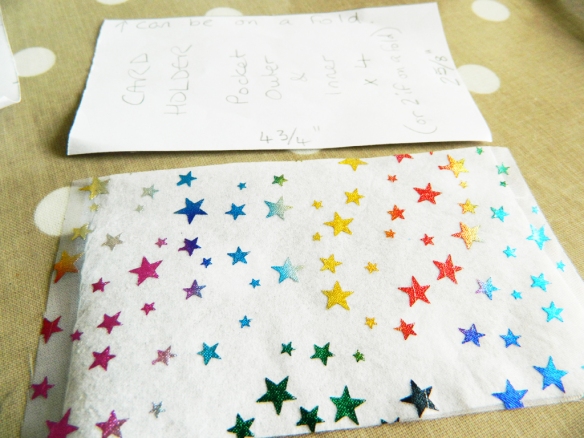
Now cut out your outer and inner main fabric pieces:

I used the selvedge here because as we are turning this inside out, I wanted an edge that was a bit more robust, and it’s a good way of making best use of fabric! Just be sure that the undyed/holes part is within the seam allowance. I had to trim about 5mm off, but it’s still sturdy without it:

Also cut out two “lining” pieces from some plain scrap to use for the inside of the pockets. Here are all the pieces laid out:

Okay, now take one of your “pocket outers” and one of your “pocket inners” in turn, and with right sides together, sew down one long side only. Remember all the seams are 3/8ths of an inch, and you don’t have to back stitch if you don’t want, as the ends will be enclosed in the next step.
Now – and remembering to use matching thread, unlike on my first attempt that I had to undo – turn them right sides out, and top stitch about 1/8th in from the edge you have just sewn, so you enclose the last row of sewing you did, and flatten what will be the top edge of your pockets. It will look neater if you sew it liner side up, and pull the liner over just a little more, so that it will be hidden when the holder is finished:

Now you need to find either something you can draw around, that is roughly 1 ½” across, or use a compass, and draw yourself a “U” shape that is roughly 2 ½” long x 1 ½” wide out of either a contrasting fabric, as here, or the same as your outer fabric. Cut out two of these. (Pic A)
With those U-shapes right sides together use the edge as your guide for the 3/8” seam allowance, and sew around the U, leaving the straight edge open. Take your time or you’ll have a wonky tab. Trim with pinking shears if you have them, or just down to about 1/8 to ¼” if you don’t. (Pic B)
Turn the right way out, I used my bone folder, it was just the right size, and press if you need to to get a good edge. Don’t push on your seams too hard or you may bust through them. (Pic C) Don’t ask me how I know this.
Top stitch in a matching (or contrasting) thread, no need to back stitch, you will be enclosing the end. (Pic D):

The next step is locating your press stud “back” on your outer fabric. It will be located at the opposite end to the one with the opening for turning the thing right sides out (so in my case it’s at the opposite end from the selvedge). And you want it to be central along the edge.
So fold under your seam allowance, and using a ruler to find the middle, and holding your “tab” that you just made slightly under the edge as if it were sewn on the other side of the holder, lower it down and (you have to guesstimate) put a pencil mark where you want it to go. Don’t worry if you only have a biro, it will be covered up by the metal stud. I put an arrow so you can see mine as it’s hard to make out with all the other dots. You don’t want to be pulling the tab hard around to get it to shut, so leave enough ease that it will just sit right. Basically, don’t put it too far in, and don’t put it too close to the edge. You will get to fine tune where your tab gets sewn later, so don’t worry too much whether it’s in the right place or not, just go with your gut:

Make a hole where your pencil mark is just through the one (outer) layer of fabric. The stud (if you’re using this type) comes in four parts. When you have them in front of you you will see there are two parts to the bottom, and two for the top. Get the back of the bottom part, and put it through the hole:
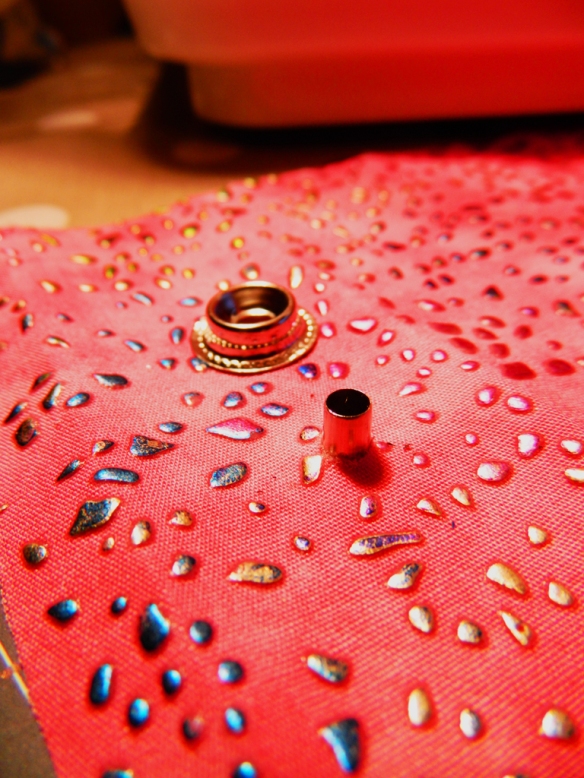
Now put the front on, and crimp with your tool, or bash the crap out of your mini tool with a hammer, (the one that came in the pack.) The next bit is for those of you who think the show “You’ve Been Framed” is full of “instructional” videos –
Don’t do this on a glass table. I don’t want emails from people saying I made you smash up their furniture. And if you do do it on your best wooden table, put something underneath so you don’t damage your french polish. A chopping board would work, but get that okay’d with the chef of the house first.
Make sure you hold the tool in place firmly, and don’t do what I did, which was to lose grip and let the tool jump to one side, causing the snap part to bend, rendering it useless until you bend it back with pliers while swearing under your breath:
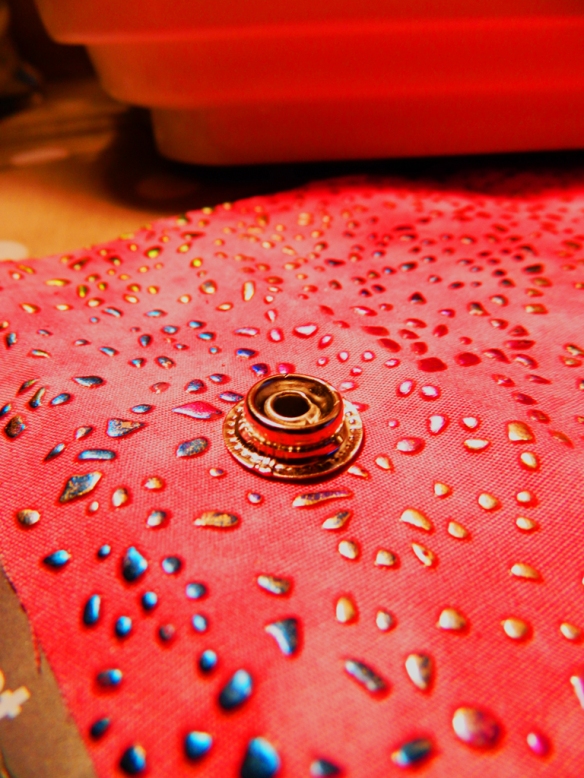
Now you basically do the same type of thing with the tab, only this time, don’t do what I did and use a rivet setting tool to set the top of your stud – unless you want a dimple in it:

Fortunately I like dimples, though usually I prefer them on faces, and not in places where there should be a nice smooth chrome dome shape, but you live and learn and these days I just count myself lucky that I still have all my fingers, but that’s largely down to self-taught DIY and mechanics mixed with a neurological disorder that fries the old brain cells, gives you the shakes and 24/7 dizziness, rather than any built in stupidity. Honest. Some days it works better to aim for the nail, and sometimes to aim for the thumb, the fun lies in guessing what type of day it is.
Okay, now back to the larger pieces. Make sure you’ve marked on where your opening is. You want to start at the bottom mark, and sew (with 3/8” seam allowance) around to the top mark, leaving a reasonable sized gap to turn it the right way out:

Lay your pieces out in this order, ‘pocket & inner fabric right sides’ facing ‘outer right side’, and press stud on the opposite end to your opening:

Snip off your corners at a greater angle than 180, as shown here, as it allows the seam allowance to sit flat when you turn it out:
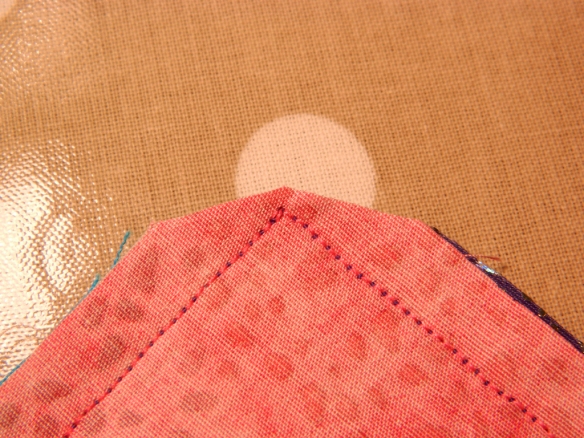
Pinking shear (or trim down) three sides to reduce bulk. Leave the opening end alone as it’s easier to sew later:

Turn the whole thing the right way out, making sure to put the pockets on the inside with the outside of them showing, like this:

Place your tab in the opening – making sure it’s the right way up – and sew the tab and the opening closed, as close to the edge as you can. You might want to remember to use the right coloured threads top and bottom, unlike me, the numpty who forgot. Not that it looks that bad, and it is on the inside after all:

Fold the whole thing down the middle, and mark the crease enough to sew a line along it. Then on one end, it doesn’t matter which, stamp out your “pilot” holes, and insert and set your rivets, with the top on the outer of the fabrics:

Now add the larger of the jump rings through the rivets, and attach the clip to this with the smaller one:

Do check out www.ilovefreegle.org if you are in the UK.

Funky Card Holder by Louise @ Snotty Dog is licensed under a Creative Commons Attribution-NonCommercial-ShareAlike 3.0 Unported License.
In other words, you can make these for yourself and your friends and family with my blessing, but you cannot use my work to sell them to make a profit, nor can you take my instructions and sell them as they are freely available here. Do click through the link for more details, ta.




